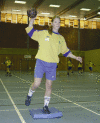Exercises to prevent lower limb injuries in youth sports: cluster randomised controlled trial
- PMID: 15699058
- PMCID: PMC549653
- DOI: 10.1136/bmj.38330.632801.8F
Exercises to prevent lower limb injuries in youth sports: cluster randomised controlled trial
Abstract
Objective: To investigate the effect of a structured warm-up programme designed to reduce the incidence of knee and ankle injuries in young people participating in sports.
Design: Cluster randomised controlled trial with clubs as the unit of randomisation.
Setting: 120 team handball clubs from central and eastern Norway (61 clubs in the intervention group, 59 in the control group) followed for one league season (eight months).
Participants: 1837 players aged 15-17 years; 958 players (808 female and 150 male) in the intervention group; 879 players (778 female and 101 male) in the control group.
Intervention: A structured warm-up programme to improve running, cutting, and landing technique as well as neuromuscular control, balance, and strength.
Main outcome measure: The rate of acute injuries to the knee or ankle.
Results: During the season, 129 acute knee or ankle injuries occurred, 81 injuries in the control group (0.9 (SE 0.09) injuries per 1000 player hours; 0.3 (SE 0.17) in training v 5.3 (SE 0.06) during matches) and 48 injuries in the intervention group (0.5 (SE 0.11) injuries per 1000 player hours; 0.2 (SE 0.18) in training v 2.5 (SE 0.06) during matches). Fewer injured players were in the intervention group than in the control group (46 (4.8%) v (76 (8.6%); relative risk intervention group v control group 0.53, 95% confidence interval 0.35 to 0.81).
Conclusion: A structured programme of warm-up exercises can prevent knee and ankle injuries in young people playing sports. Preventive training should therefore be introduced as an integral part of youth sports programmes.
Figures






Similar articles
-
Structured exercises to prevent lower limb injuries in young handball players.Clin J Sport Med. 2005 Sep;15(5):398. doi: 10.1097/01.jsm.0000179229.78532.0c. Clin J Sport Med. 2005. PMID: 16163002
-
Neuromuscular training to prevent knee injuries in adolescent female soccer players.Clin J Sport Med. 2013 Sep;23(5):407-8. doi: 10.1097/01.jsm.0000433153.51313.6b. Clin J Sport Med. 2013. PMID: 23989384
-
The effectiveness of a neuromuscular prevention strategy to reduce injuries in youth soccer: a cluster-randomised controlled trial.Br J Sports Med. 2010 Jun;44(8):555-62. doi: 10.1136/bjsm.2010.074377. Br J Sports Med. 2010. PMID: 20547668 Clinical Trial.
-
[Sports injuries in children and adolescents: etiology, epidemiology, and risk factors].Acta Orthop Traumatol Turc. 2004;38 Suppl 1:27-31. Acta Orthop Traumatol Turc. 2004. PMID: 15187455 Review. Turkish.
-
Understanding injury mechanisms: a key component of preventing injuries in sport.Br J Sports Med. 2005 Jun;39(6):324-9. doi: 10.1136/bjsm.2005.018341. Br J Sports Med. 2005. PMID: 15911600 Free PMC article. Review.
Cited by
-
Effect of the FIFA 11+ soccer specific warm up programme on the incidence of injuries: A cluster-randomised controlled trial.PLoS One. 2021 May 24;16(5):e0251839. doi: 10.1371/journal.pone.0251839. eCollection 2021. PLoS One. 2021. PMID: 34029321 Free PMC article. Clinical Trial.
-
Canadian High School Rugby Coaches Readiness for an Injury Prevention Strategy Implementation: Evaluating a Train-the-Coach Workshop.Front Sports Act Living. 2021 May 31;3:672603. doi: 10.3389/fspor.2021.672603. eCollection 2021. Front Sports Act Living. 2021. PMID: 34136807 Free PMC article.
-
Effect of sensorimotor training on morphological, neurophysiological and functional characteristics of the ankle: a critical review.Sports Med. 2009;39(7):591-605. doi: 10.2165/00007256-200939070-00005. Sports Med. 2009. PMID: 19530753 Review.
-
Whole body muscle activity during the FIFA 11+ program evaluated by positron emission tomography.PLoS One. 2013 Sep 16;8(9):e73898. doi: 10.1371/journal.pone.0073898. eCollection 2013. PLoS One. 2013. PMID: 24066082 Free PMC article.
-
Psychosocial education improves low back pain beliefs: results from a cluster randomized clinical trial (NCT00373009) in a primary prevention setting.Eur Spine J. 2009 Jul;18(7):1050-8. doi: 10.1007/s00586-009-1016-7. Epub 2009 May 6. Eur Spine J. 2009. PMID: 19418075 Free PMC article. Clinical Trial.
References
-
- Pate RR, Pratt M, Blair SN, Haskell WL, Macera CA, Bouchard C, et al. Physical activity and public health. A recommendation from the Centers for Disease Control and Prevention and the American College of Sports Medicine. JAMA 1995;273: 402-7. - PubMed
-
- Fletcher GF, Balady G, Blair SN, Blumenthal J, Caspersen C, Chaitman B, et al. Statement on exercise: benefits and recommendations for physical activity programs for all Americans. A statement for health professionals by the Committee on Exercise and Cardiac Rehabilitation of the Council on Clinical Cardiology, American Heart Association. Circulation 1996;94: 857-62. - PubMed
-
- Bahr R, Kannus P, van Mechelen. Epidemiology and prevention of sports injuries. In: Kjær M, Krogsgaard M, Magnusson P, Engebretsen L, Roos H, Takala T, et al. Textbook of sports medicine. Basic science and clinical aspects of sports injury and physical activity. Blackwell Science, 2003: 299-314.
-
- Arendt E, Dick R. Knee injury patterns among men and women in collegiate basketball and soccer. NCAA data and review of literature. Am J Sports Med 1995;23: 694-701. - PubMed
-
- Myklebust G, Maehlum S, Engebretsen L, Strand T, Solheim E. Registration of cruciate ligament injuries in Norwegian top level team handball. A prospective study covering two seasons. Scand J Med Sci Sports 1997;7: 289-92. - PubMed
Publication types
MeSH terms
LinkOut - more resources
Full Text Sources
Medical
